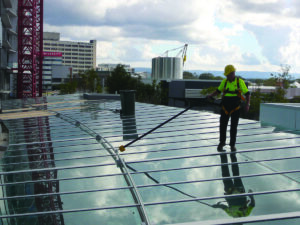Safe & Secure
The Many Benefits of Proactive Safety & Fall Protection Programs
 By Philip Jacklin, Continuing Education Program Manager, Diversified Fall Protection
By Philip Jacklin, Continuing Education Program Manager, Diversified Fall Protection
While most construction companies need fall protection programs, it’s unlikely most contractors are faced with the frequency of fall hazards as those in the roofing industry. Standard contractors sometimes have the luxury that working at heights is an exception from their standard tasks. But roofing contractors hardly get the opportunity to work on the ground. It is common for safety managers at roofing companies to get overwhelmed with running proactive fall protection programs. From keeping up to date with the Occupational Safety and Health Administration (OSHA) regulation updates to incorporating new safety innovations from manufacturers, even the monotony of ensuring each worker receives regular, quality training can be daunting for anyone. However, the rewards of investing in a robust fall protection program can do much more than keep workers safe. It can help make the business more profitable, help win bids over competitors, improve morale, and improve employee retention.
OSHA mandates that employers keep workplaces safe from all known hazards to the best of their knowledge and ability. Ethically, organizations should want all employees and trade partners to be able to complete their work tasks without risk of injury or fatality. Workplace health, safety, and fall protection programs can directly contribute to the improved well-being of employees. Studies have shown that companies that have invested in expanding these programs can benefit from increased productivity, boosted morale, increased employee retention, and a competitive advantage in the marketplace.

Safety should not be the only department within the organization motivated to increase worker safety. From a logistical perspective, workplace injuries can set projects back behind schedule and potentially reduce the number of available workers for the rest of a given project. Supporting safety programs can increase the percentage of workers who report for work each day. Additionally, new hires or interim staff to replace an injured worker divert hours from production/labor and incur costs while training and onboarding.
From a financial perspective, the direct and indirect costs after an injury, fatal or non-fatal, can be avoided if safety programs are supported, adopted, and successful. Some of the potential direct costs associated with an injury can be worker’s compensation payouts, medical expenses, OSHA regulatory and compliance fines, if applicable, and litigation fees. Some sources estimate the indirect costs can be four times as much as direct costs, and even more if the injury is fatal to the worker. Each week in the United States, OSHA estimates roughly one billion dollars are spent by companies in long-time worker’s compensation payouts.

In recent years, companies have faced labor shortages across all trades and industries. The Centers for Disease Control and Prevention has found that companies supporting employee safety and health programs see an increase in employee loyalty. The costs associated with continually onboarding new employees include training, outfitting with Personal Protective Equipment (PPE) like fall protection harnesses, and more can add up quickly. Additionally, if employees feel safe at their workplace, they tend to stay at their company longer. That year-over-year familiarity with the company’s programs can help foster a unified culture of safety that employees to grow more familiar with and are more empowered to follow safety practices, at work and even at home.
Regular training sessions, especially among established work crews, can help build camaraderie and open channels to communicate hazards in the workplace. For example, before a morning safety huddle, toolbox talk, or whatever an organization may call their safety trainings, asking the question, “What is one thing we can do to work safer today?” to the audience can bring notice to hazards that management might have originally overlooked. Nobody knows the ins and outs of a workplace like the workers on the frontline. If a company wants to improve the safety of its maintenance mechanics, it should ask their maintenance crew about their biggest concerns. If a company wants to improve the safety of their transport drivers, they should ask the drivers what they’ve heard other companies do to improve driver safety. Safety leadership should have constant communication with all departments to ensure safety policies are being followed and, if not, how they can be improved to increase compliance.

As one can see, there are many ways organizations can greatly benefit from supporting their employee health and safety programs. However, while most companies can agree on these benefits, they often find challenges in executing effective training curriculums with limited resources. Too often, safety programs are established without the proper funding to successfully operate at full effectiveness. Safety managers should become familiar with their vendor partners and the training options they might provide. In the PPE and safety equipment industries, it is common for manufacturer’s representatives to offer complimentary trainings following up on recent or past purchases.
Most importantly, those in charge of developing comprehensive health and safety programs should know that they are not alone in their efforts. Every day, safety professionals network online to discuss policies that have improved their organization’s safety record, mistakes they would recommend that others avoid, and many more valuable conversations. Organizations like the American Society of Safety Professionals and the National Safety Council host frequent, regional meetings for safety professionals to meet virtually or in-person and discuss corporate safety programs and offer advice to others.
